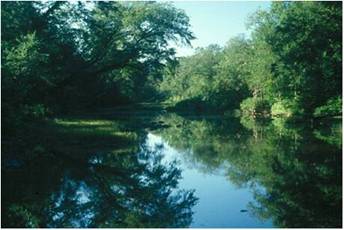
Agricultural News
Efforts of Oklahoma Conservation Partners and Producers Paying Off
Wed, 09 Mar 2011 13:18:38 CST
 With 78,500 miles of rivers and streams throughout Oklahoma, it's hard to imagine how effective water quality monitoring is even possible. That distance equates to about three times the circumference of the earth. But Oklahomans, determined to improve water quality, have found the recipe for success. Blend federal, state and local conservation partners, add local farmers, ranchers and producers, and mix well. Top with programs, special initiatives, education, and cost share incentives and what do you get? A Bridge over 'not so' troubled waters. Results show that with collaborative efforts, strong partnerships, and a common goal, success is sure to follow.
With 78,500 miles of rivers and streams throughout Oklahoma, it's hard to imagine how effective water quality monitoring is even possible. That distance equates to about three times the circumference of the earth. But Oklahomans, determined to improve water quality, have found the recipe for success. Blend federal, state and local conservation partners, add local farmers, ranchers and producers, and mix well. Top with programs, special initiatives, education, and cost share incentives and what do you get? A Bridge over 'not so' troubled waters. Results show that with collaborative efforts, strong partnerships, and a common goal, success is sure to follow.
The Natural Resources Conservation Service (NRCS) received funding for a water quality initiative in the Illinois River Sub-Basin and Eucha-Spavinaw Watershed in northeastern Oklahoma and northwestern Arkansas. The purpose of the funding is to improve water quality within the project area (which includes Lake Tenkiller, Lake Eucha and Lake Spavinaw in Oklahoma). The Illinois River is a scenic river that supports an important tourism industry based on recreation activities like fishing and swimming and Lake Tenkiller serves as an important water supply for surrounding communities. These activities represent three human body contact beneficial uses of water according to Oklahoma water quality standards.
High concentrations of nitrogen, phosphorus, sediments and bacteria plagued the area's water bodies. Potential non-point sources of these degrading agents included runoff from land surfaces after application of animal manure/litter as fertilizer on pastures, soil erosion, re-suspension of streambed sediments and nutrients from poultry and other livestock farming operations within the area. Efforts were already underway in 1998, when the Oklahoma Conservation Commission and the Delaware County Conservation District initiated a series of projects to improve the water quality of Lakes Eucha and Spavinaw and their supplying streams.
In 1987, the EPA officially recognized that nonpoint source (NPS) pollution was impairing the nation's waters and preventing them from meeting the "fishable and swimmable" goals of the Clean Water Act. A new section called 319 NPS Management Programs was added to the Clean Water Act. Under the 319 program each state is required to assess their waters for NPS pollution and develop a management program that deals with the pollution. The Oklahoma Conservation Commission is the state's lead agency for the 319 Program. OCC monitors approximately 500 streams on a rotating basis.
Through conservation partners and agencies offering funded programs, a significant reduction in NPS pollution occurred in the project area targeted by the funding. Programs include the NRCS Environmental Quality Incentives Program (EQIP), the Conservation Reserve Enhancement Program (CREP), U.S. Environmental Protection Agency (EPA) 319 Nonpoint Source Program and the Oklahoma Conservation Commission (OCC) Water Quality Division.
Oklahoma NRCS programs assisted 86 farm and ranch operations covering 30,364 acres to voluntarily apply conservation practices. As a result, 485 acres of riparian buffer zones along stream corridors were created and 478,181 feet of fence to prevent random animal access to streams were installed. A combined 36 cakeout and composter facilities were constructed to cover 5,951 square feet to prevent animal waste discharge into surface water, 121 old or out dated septic systems replaced, and 609 acres of grazing land received improved vegetative cover. When accounting for the programs of the other agencies, the numbers are much higher.
Oklahoma's Impaired Waters List, commonly known as the 303(d) list, are waters too polluted or otherwise degraded to meet water quality standards set by states. Last year, Oklahoma removed four streams from the list due to improvement shown with most recent monitoring data. Eight additional streams from Oklahoma's proposed 2010 impaired-waters list were submitted for removal this past summer.
In addition to reaching out to landowners and poultry/cattle producers with educational information, stream monitoring continues and best management practices are being installed on a voluntary, cost-share basis. Some of those practices include: riparian area/buffer zone establishment, exclusion fencing, alternative water supplies, vegetative plantings, cross fencing, animal waste management components, rural waste septic systems, stream bank stabilization, cross fencing, planting pasture that was formerly cropland or poorly vegetated pasture, water tanks, ponds, and wells to optimize pasture usage.
In 2010, analysis of nutrient and sediment reduction numbers from across the nation showed that Oklahoma ranks among the top five for states reducing contamination in the streams and rivers, according to the EPA. The 319 Program Success Stories showcase improved water quality. The dedicated work of farmers, ranchers and producers to control NPS pollution by using voluntary programs, is paying off. More than 10 percent of the total amount of nitrogen reduced from water nationwide was accounted for by reductions in Oklahoma. Of the total national reductions of phosphorous in water, more than 16 percent of all reductions happened in Oklahoma.
Our thanks to Teri Daniel of the Oklahoma state office of the NRCS- Teri is the author of this analysis of the prositive impact conservation practices are having on the environment in Oklahoma.
WebReadyTM Powered by WireReady® NSI
Top Agricultural News
More Headlines...


















